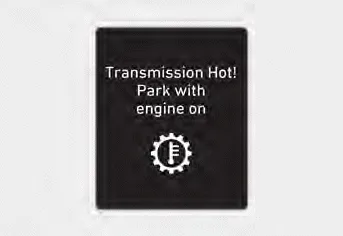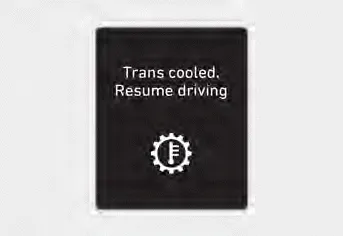Hyundai Santa Fe (TM): Four Wheel Drive (4WD) operation / For safe 4WD operation
Before driving
- Make sure all passengers are wearing seat belts.
- Sit upright and closer to the steering wheel than usual. Adjust the steering wheel to a position comfortable for you to drive.
Driving on snow-covered or icy roads
- Start off slowly by applying the accelerator pedal gently.
- Use snow tires or tire chains.
- Keep sufficient distance between your vehicle and the vehicle in front of you.
- Apply engine braking during deceleration by using the paddle shifter (manual shift mode) and manually selecting a lower gear.
- Avoid speeding, rapid acceleration, sudden brake applications, and sharp turns to prevent skids.
Information
When using Snow Tires, mount them on all four wheels.
If a full set of chains is not available for an 4WD vehicle when using tire chains, chains may be installed on the front wheels only.
For more details on Snow Tires and Tire Chains, refer to "Winter Driving" section later in this chapter.
CAUTION
Mud or snow
If one of the front or rear wheels begins to spin in mud, snow, etc., the vehicle can sometimes be driven out by engaging the accelerator pedal further; however avoid running the engine continuously at high rpm because doing so could damage the AWD system.
Driving in sand or mud
- Maintain slow and constant speed. Operate the accelerator pedal slowly to ensure safe driving (wheel-slip prevention).
- Keep sufficient distance between your vehicle and the vehicle in front of you.
- Reduce vehicle speed and always check the road condition.
- Avoid speeding, rapid acceleration, sudden brake applications, and sharp turns to prevent getting stuck.
- When the vehicle is stuck in snow, sand or mud, the tires may not operate.
- This is to protect the transmission and not a malfunction.
NOTICE
Moving the vehicle forcibly to get out of mud or sand can cause damage/ overheat of the engine or damage/ breakdown of the transmission, differential or 4WD system as well as damage to tires. If excessive wheel slip occurs after entering a sandy/muddy road, the vehicle may fall into the sand/ mud. When it happens, put a stone or a tree branch under the tire, and then try to pull out the vehicle, or try to get it unstuck by repeatedly moving forwards and backwards.
Transmission overheated


- When driving on muddy and sandy roads under the severe condition, the transmission could be overheated.
- When the transmission is overheated, the safe protection mode engages and the “Transmission Hot! Park with engine on: warning message will appear on the LCD display with a chime.
- If this occurs, pull over to a safe location, stop the vehicle with the engine running, apply the brakes and shift the vehicle to P (Park), and allow the transmission to cool.
- If you ignore this warning, the driving condition may become worse. You may experience abrupt shifts, frequent shifts, or jerkiness. To return to the normal driving condition, stop the vehicle and apply the foot brake or shift into P (Park). Then allow the transmission to cool for a few minutes with engine on, before driving off.
- When the message “Trans cooled. Resume driving” appears you can continue to drive your vehicle.
- If the warning messages in the LCD display continue to blink, for your safety, have the system checked by an authorized HYUNDAI dealer.
Driving up or down hills
- Driving uphill
- Before starting off, check if it is possible to drive uphill.
- Drive as straight as possible. - Driving downhill
- Do not change gear while driving downhill. Select gear before driving downhill.
- Drive slowly using engine braking while driving downhill.
- Drive straight as possible.
WARNING
Exercise extreme caution driving up or down steep hills. The vehicle may flip over depending on the grade, terrain, water and mud conditions.
WARNING
Do not drive across the contour of steep hills. A slight change in the wheel angle can destabilize the vehicle, or a stable vehicle may lose stability if the vehicle stops its forward motion. Your vehicle may roll over and lead to a serious injury or death.
Driving through water
- Try to avoid driving in deep standing water. It may stall your engine and clog your exhaust pipes.
- Do not change gear while driving in water.
CAUTION
Always drive slowly in water. If you drive too fast, water may get into the engine compartment and wet the ignition system causing your vehicle to suddenly stop.
Additional driving conditions
- Become familiar with the off-road conditions before driving.
- Always pay attention when driving offroad and avoid dangerous areas.
- Drive slowly when driving in heavy wind.
- Reduce vehicle speed when cornering. The center of gravity of 4WD vehicles is higher than conventional 2WD vehicles, making them more likely to roll over when you rapidly turn corners.
- Always hold the steering wheel firmly when you are driving off-road.
WARNING
Do hold the steering wheel tightly when you are driving off-road. You may hurt your arm by a sudden steering maneuver or from steering wheel rebound due to an impact with objects on the ground. You could lose control of the steering wheel which may lead to serious injury or death.
Auto Four Wheel Drive mode (normal driving) If the 4WD system determines there is a need for four wheel drive, the engine's driving power is distributed to all four wheels automatically.
Tires When replacing tires, be sure to equip all four tires with the same size, type, tread patterns, brand and load-carrying capacity. WARNING Do not use tire and wheel with different size and type from the one originally installed on your vehicle.
Other information:
Hyundai Santa Fe (TM) 2019-2023 Service and Repair Manual: Components and components location
Hyundai Santa Fe (TM) 2019-2023 Service and Repair Manual: Components and components location
Component Location 1. Integrated Body Control Unit (IBU) 2. Ultrasonic Sensor ※ PDW function is applied alone, it is integrated into IBU (Integrated Body Control Unit). ※ PDW function is applied with RSPA function, it is integrated into ADAS_PRK controller.
Categories
- Manuals Home
- Hyundai Santa Fe Owners Manual
- Hyundai Santa Fe Service Manual
- System settings
- Front Radar Unit. Repair procedures
- Rear Bumper Assembly. Repair procedures
- New on site
- Most important about car
